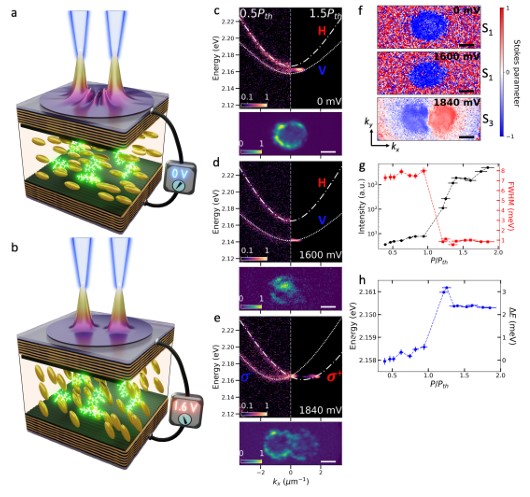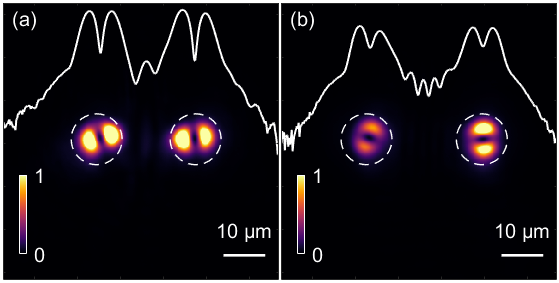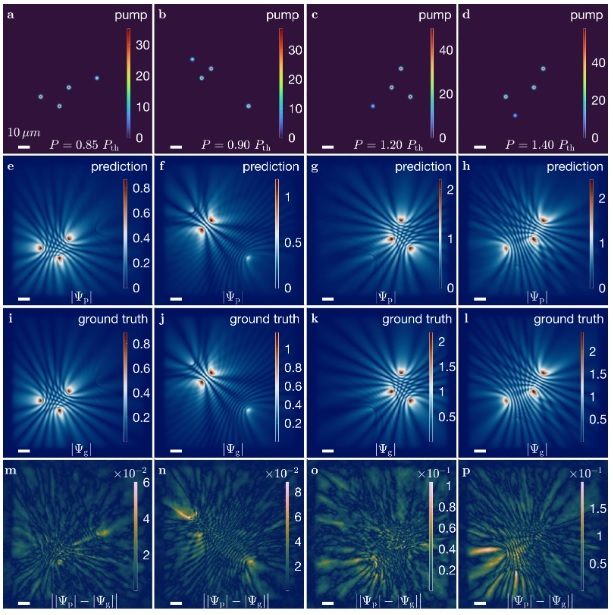
Electrically Reconfigurable Extended Lasing State in an Organic Liquid-Crystal Microcavity
D. Dovzhenko, L. S. Ricco, K. Sawicki, M. Muszyński, P. Kokhanchik, P. Kapuściński, P. Morawiak, W. Piecek, P. Nyga, P. Kula, D. Solnyshkov, G. Malpuech, H. Sigurðsson, J. Szczytko, S. De Liberato
arXiv:2506.05717v1
Here we demonstrate electrically controlled in-plane interaction between optically reconfigurable spatially separated lasing states, operating at room temperature in the weak light-matter coupling regime. We show spatially extended coherent lasing state or "supermode" with wide-range micro-scale control of near-field, far-field and on-chip phase-locking tuning functionality.

Observation of 𝜎-𝜋 coupling and mode selection in optically trapped artificial polariton molecules
K. Sawicki, V. K. Daníelsson, D. Dovzhenko, P. G. Lagoudakis, S. De Liberato, H. Sigurðsson
Optica (2025).
Here, we explore this coupling mechanism between polariton condensates populating the first excited $p$-state manifold of coupled optically trapped condensates and show a rich structure of patterns based on excitation parameters. The optical reconfigurability of the laser excitation patterns enables the creation of an annular-shaped beam to confine polaritons in a tailored trapping potential, whilst the dissipative nature of the optical traps enables effective interaction with neighboring condensates.

A Fourier Neural Operator Approach for Modelling Exciton-Polariton Condensate Systems
Y. Wang, S. T. Sathujoda, K. Sawicki, K. Gandhi, A. I Aviles-Rivero, P. G. Lagoudakis
Communications Physics (2025).
In this work, we study the application of the FNO architecture to approximate solutions to the GPE. We are interested in this specific variant of Neural Operator as its mathematical formulation relates very closely to the SplitStep Fourier Method (SSFM), which is the numerical method used to solve the GPE in this instance.

Occupancy-driven Zeeman suppression and inversion in trapped polariton condensates
K. Sawicki, D. Dovzhenko, Y. Wang, T. Cookson, H. Sigurðsson, P. G. Lagoudakis
Physical Review B 109, 125307 (2024). [Editors' suggestion]
Extremely high coherence time and, thus, ultra-narrow spectral linewidths make it possible to resolve magnetically induced µeV fine-energy shifts in trapped exciton-polariton condensates. The continuous control over the polariton confinement enabled authors to explore two operation regimes: (1) the full parametric screening of the Zeeman splitting and (2) the Zeeman inversion regime. The transition from one range to the other occurs by adjusting the size of the optical trap, which controls the strength of the polariton-polariton and polariton-exciton reservoir interactions.

Reconfigurable photon localization by coherent drive and dissipation in photonic lattices
O. Jamadi, B. Real, K. Sawicki, C. Hainaut, A. González-Tudela, N. Pernet, I. Sagnes, M. Morassi, A. Lemaître, L. Le Gratiet, A. Harouri, S. Ravets, J. Bloch, A. Amo
Optica Vol. 9, Issue 7, pp. 706-712 (2022).
Here, we show that in lattices of lossy resonators, the addition of external optical drives with a controlled phase enlarges the possibilities of manipulating interference effects and allows for the design of novel types of localized modes. Using a honeycomb lattice of coupled micropillars resonantly driven with several laser spots at energies within its photonic bands, we demonstrate the localization of light in at-will geometries down to a single site.

Polariton lasing and energy-degenerate parametric scattering in non-resonantly driven coupled planar microcavities
K. Sawicki, T. J. Sturges, M. Ściesiek, T. Kazimierczuk, K. Sobczak, A. Golnik, W. Pacuski J. Suffczyński
Nanophotonics 10(9) 2421-2429 (2021).
Here, we report non-equilibrium Bose–Einstein condensation of exciton-polaritons and low threshold, dual-wavelength polariton lasing in vertically coupled, double planar microcavities. Moreover, we find that the presence of the non-resonantly driven condensate triggers interbranch exciton-polariton transfer in the form of energy-degenerate parametric scattering.






